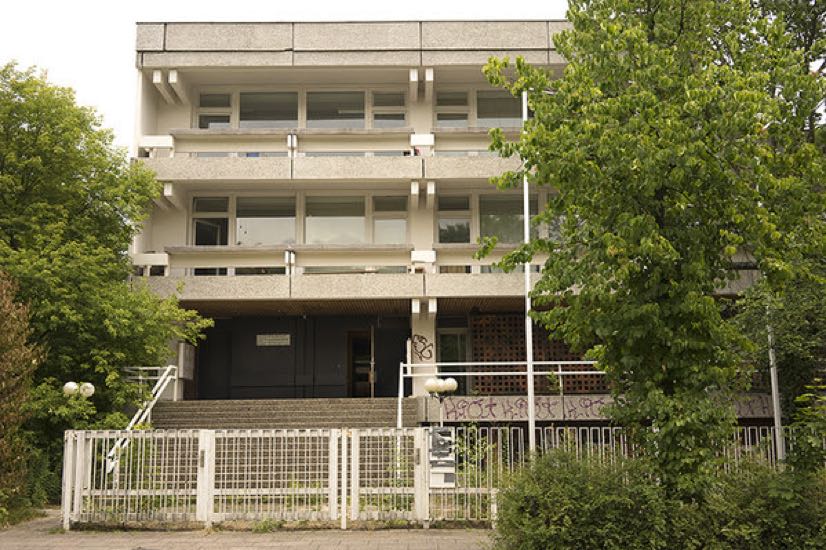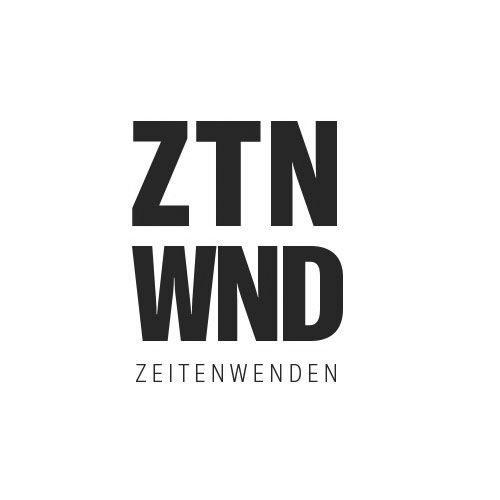EX-EMBASSY presents from 4th August 2018 the exhibition and text series with the artists Megan Cope (Quandamooka); Archie Moore (Kamilaroi); Sumugan Sivanesan (AU) & Carl Gerber (DE); Sonya Schönberger (DE); and Khadija von Zinnenburg Carroll (AU / UK) and texts by cultural scientist Ben Gook (AU); Legal scholar Sarah Keenan (UK); Historian Peter Monteath (AU); Artist, critic and curator Rachel O’Reilly (AU); and author Nathan Sentance (Wiradjuri). EX-EMBASSY is hosted by artist Sonja Hornung (AU / NL) with curatorial advice from Rachel O’Reilly (AU).
Image above: Courtesy of EX-EMBASSY – photo Adrian Knuppertz
EX-EMBASSY is an exhibition and text series that unfolds from the former Australian embassy in the German Democratic Republic (GDR). Five artistic works and five texts are located in and around this iconic modernist structure.
Built between 1973 and 1975, the former embassy is part of a barely known but unprecedented architectural experiment: in the late 1960s and early 1970s, 135 diplomatic buildings were erected in the peripheral northeast of Berlin, in Pankow, for a short period of time. Virtually without national symbolism these prefabricated, modular structures are still scattered throughout Pankow.
Australia, often referred to in the communiqués of the GDR as the “fifth continent”, plays a subordinate role in the history of the Cold War. As the second Western state to recognize the GDR, Australia would receive the largest embassy model: the “Ingenieur-Hochbau-III”, designed by a group led by Horst Bauer, also an architect of the East Berlin icon Café Moskau.
While the GDR fought for international recognition, the settler colony Australia in its own country responded to social movements with democratic reforms, including the late recognition of Aboriginal claims to their lands, redefining their territorial power in the Asia-Pacific region. Australia’s more or less incompatible diplomatic relations with the GDR officially bore little fruit and were abandoned before the fall of the Wall. The embassy was one of many East German state goods that were privatized as part of the West German-controlled trustee process at a low price. According to geographer Doreen Massey’s definition of space as “simultaneity of past stories”, EX-EMBASSY addresses the former message as a place shaped and envisioned by passages far beyond the physical context. The works and texts on display depict stories of diplomatic performance that destabilize revised narratives and capitalist property formats, as well as historical and current negotiations on value and territory; Narration and identity.
Parallel to the EX-EMBASSY, a local artists’ association has formed to remove the listed building from the real estate market and to secure it as a studio house and permanent cultural site.
Participating artists include: Megan Cope (Quandamooka); Archie Moore (Kamilaroi); Sumugan Sivanesan (AU) & Carl Gerber (DE); Sonya Schönberger (DE); and Khadija of Zinnenburg Carroll (AU / UK). With texts by: cultural scientist Ben Gook (AU); Legal scholar Sarah Keenan (UK); Historian Peter Monteath (AU); Artist, critic and curator Rachel O’Reilly (AU); and author Nathan Sentance (Wiradjuri). EX-EMBASSY is organized by the artist Sonja Hornung (AU / NL) with curatorial advice from Rachel O’Reilly (AU).
EX-EMBASSY will be part of the Berlin Project Space Festival 2018. This project was supported by the Australian Government through the Australia Council for the Arts’s funding and advisory body and by the Rosa Luxemburg Foundation through the Helle Panke e.V.
EX-EMBASSY was conceived by visual artist Sonja Hornung, who in close collaboration with Rachel O’Reilly’s Curatorial Consultancy has created an archive of the site for and in conversation with the participating artists and authors of the exhibition. The video work The Blaktism by Quandamooka artist Megan Cope is a satirical ritual in which an Aborigine is recognized and classified as such by the white cultural authorities. Khadija of Zinnenburg Carroll (AU / AT) is presenting an installation and performance work based on archival material collected over almost ten years in the context of the former Australian Embassy and its abandoned architectural twin, the former Iraqi Embassy, while the historian Peter Monteath (AU) wrote a text negotiating archive fragments on the contradictory relationship between the “fifth continent” and “Pankow”. Rachel O’Reilly (AU / DE) addresses the political formalism of “non-art art” (Vesic) within certain historical configurations dictated by the site. Sumugan Sivanesan (AU / DE) & Carl Gerber (DE) perform an unequaled tennis match on the tennis court of the Embassy, which addresses the ‘(un) diplomatic arts of black body politics’. Sarah Keenan (AU / UK) writes from a critical legal perspective on the relationship between colonial logic, property, and affiliation systems, while the embassy garden, originally designed for the enjoyment and freedom of movement of diplomatic guests, was designed by Archie Moore ( Kamilaroi) is disturbed in order to draw attention to the forcible assignment of certain bodies to certain rooms. Nathan Sentance (Wiradjuri) explores the role of institutional architecture in the eradication of planetary social memory sites as a result of colonial invasion. A text by Ben Gook (AU / DE) compares neo-liberalization processes in Australia and (East) Germany and their impact on the use of spaces and social identities, while an action by Sonya Schönberger (DE) with the motif of weeds compares the relationship between art Gentrification and manipulated and controlled affiliation on the outskirts of the city are critically reflected.
Carl Gerber, born 1985 in Mainz, studied from 2007-2013 screenplay at the Filmhochschule Ludwigsburg. During his studies, Carl’s book templates produced award-winning short films, including Syncope, which was nominated for the German Short Film Award. His Short Stories The Examination of the Eye and First First were published by the Primero publishing house. In 2012, Carl was head of a film workshop for Syrian refugee children on the Turkish-Syrian border. In Berlin he is part of the Newsgroup Afghanistan, which has put together photo exhibitions, a play and a book publication on homeland, flight and the German asylum process. Since 2013, Carl has been working as a performance dramaturge in various constellations. His works were in the Sophiensäle Berlin, Ballhaus Ost Berlin and Harburger Bahnhof u.a. shown. With his first feature film 24 weeks in 2016 he succeeded in the only German contribution in the competition of the 66th Berlinale. After a festival and cinema tour through more than 30 countries, the film was nominated four times for the German Film Prize in 2017, including the best screenplay. The film won the “Silver Lola”.
Archie Moore (Kamilaroi, born 1970, Toowoomba, lives in Brisbane) works across media on depictions of self-history and national history. His permanent interests include the key features of identity – skin, language, smell, home, flags – as well as the limits of intercultural understanding and misunderstanding, including the broader meaning of racism. Uncertainty is a constant theme that affects his paternal kamilaroi heritage. Moore graduated in 1998 with a Bachelor of Visual Arts degree from Queensland University of Technology. In 2001, he received the Millenial Anne & Gordon Saturday International Visual Arts scholarship, which enabled him to study at the Academy of Fine Arts in Prague. For two decades, he has regularly hosted solo exhibitions of his work in universities, nonprofit and commercial galleries throughout Australia, and has been invited to solo and double exhibitions in the UK and Japan. He was commissioned for the 3rd National Indigenous Art Triennale and the 20th Biennale in Sydney.
Sonya Schönberger combines her studies of ethnology and experimental media design in her artistic practice. In the last eight years she has built up a long-term project to archive an archive in which she conducted private discussions in Germany, the USA and Israel with contemporary witnesses of the Second World War. With the help of this ‘Archive of Memories’ she examines the effects of a nation’s traumas on future generations. The artist consciously and depending on the project uses different media such as photography, theater, film, installation or audio formats.
Megan Cope is a Quandamooka from North Stradbroke Island in southeastern Queensland. She lives and works in Brisbane. Her site-specific sculptural installations, video works and paintings explore the myths and methods of colonization. Her diverse practice also addresses questions of identity, the environment and mapping practice. Copes works have been exhibited in Australia and internationally, including the Queensland Art Gallery / Gallery of Modern Art; Gold Coast City Art Gallery; MONA FOMA, Hobart; ARC Biennial, Brisbane; Cairns Regional Art Gallery; Koori Heritage Trust, Melbourne; City Gallery, Wellington; Para Site Contemporary Art Space, Hong Kong; Careof Art Space, Milan; The Australian Embassy, Washington and Next Wave Festival, 2014. Cope was commissioned to create large site-specific works at the Queensland Art Gallery, 2013, and the Melbourne Museum, 2015. Cope is a member of the Aboriginal art collective proppaNOW.
Sumugan Sivanesan (Sydney / Berlin) is a multidisciplinary artist, writer, researcher and educator. His research interests include: Experimental Media Art, Contemporary Art and Activism, Environmental Humanities, Queer Theory and Tamil Studies. He has shown performances, screenings, events and exhibitions at the School for Machines, Making & Make Believe (Berlin 2017), the Images Festival Toronto (2017, 2010), the Museum of Contemporary Art (Sydney, 2016, 2010) and the Transmediale (Berlin 2016), Art Laboratory Berlin (2015), ZK / U Center for Art and Urban Studies, Berlin (2015, 2014), Perth Institute of Contemporary Arts (2014), The Reading Room (Bangkok 2013), Performance Space (Sydney 2013) and 4A Center for Contemporary Asian Art (Sydney 2011, 2010). He was part of the experimental documentary collective theweathergroup_U for the Sydney Biennale in 2008.
Khadija von Zinnenburg Carroll is an Australian artist living in Austria and Professor of Global Art History at the University of Birmingham. Her practice examines how to intervene ethically and experimentally in neoliberal institutions. This form of institutional activism, together with the use of site-specific installation strategies, questions the influence of the market on art and research, and reflects the intersections of both on an “ethnographic conceptualism”. Khadija is the author of the books Art in the Time of Colony; Botanical Drift: Plant Protagonists of the Invasive Herbarium; and The Importance of Being Anachronistic. Her work has been shown at Extracity, Savvy Contemporary Berlin, the Pitt Rivers and the House of World Cultures Berlin. As an expert on contemporary art and colonialism, as well as museum and collection history, she earned her doctorate at Harvard University on the art of the Aborigines. Her installations and texts were exhibited at the Venice Biennale, the Marrakech Biennale and the Silver Yearning. She is a scholarship holder of the British Academy and the Humboldt Foundation and publisher of the magazine Third Text.
BIOGRAPHIES – CONTRIBUTING AUTHOR
Ben Gook (AU / DE) is a postdoctoral fellow of the Alexander von Humboldt Foundation at the Humboldt University Berlin. As a Fellow of the School of Social and Political Sciences, he also volunteers at the University of Melbourne. He received his doctorate in 2014 in Social Theory and Cultural Studies from the University of Melbourne. He researches contemporary German politics, economics and culture with a focus on social change after the fall of the Berlin Wall. His first book is Divided Subjects, Invisible Borders: Re-unified Germany after 1989 (London: Rowman & Littlefield, 2015). He has also written on Australian culture, including “Australian Postcolonial Trauma and Silences at Samson and Delilah,” Scars and Wounds: Trauma on Film in National and International Contexts, 2017) and “… With Ears for Landscape: Australian Soundscapes.” , Crossings (2006). His essay “Lest we Forget; Let us forget” (2013) responded to Nothing to See Here by Amy Spiers and Catherine Ryan at the Underbelly Arts Festival in Sydney.
Sarah Keenan is Senior Lecturer at Birkbeck Law School and Co-Director of the Center for Research on Race and Law. Trained as a lawyer in Australia, her research uses feminist and critical racial theories to rethink questions of space, property, and identity. Her book Subversive Property: Law and the Production of Spaces of Belonging was published by Routledge in 2014 and she is currently a Leverhulme Fellow with her project Making Land Liquid: The Temporality of Land Title Registration.
Peter Monteath is Professor of History at Flinders University in Adelaide. He taught at the University of Queensland, Deakin University, the University of Western Australia, the University of Adelaide, and Flinders University. He was also a visiting professor at the University of St. Louis Missouri and the Technical University of Berlin, where he was Alexander von Humboldt Fellow. His research interests lie in the areas of German and Australian modern history and in the connections between the two. His most famous book is POW: Australian Prisoners of War in Hitler’s Reich (Sydney 2011). In 2015, together with co-author Valerie Munt, he published a biography of anthropologist Fred Rose entitled Red Professor: The Cold War Life of Fred Rose. The book, which is based on extensive work in Australian and German archives, was nominated in 2016 for the History Prize of the Prime Minister. Currently, Peter Monteath teaches and researches at Flinders University and is president of the History Council of South Australia.
Nathan “mudyi” Sentance is Wiradjuri and a creative producer committed to ensuring that the cultural and historical narratives conveyed by cultural and memory institutions, such as galleries, libraries, archives and museums (GLAM), have a perspective of the first nations and that the stories of the first nations are narrated and controlled by the people of the first nations. This is intended to offset the distortions and misinterpretations of the Aboriginal peoples and Aboriginal peoples previously spread by the GLAM institutions. Nathan also participated in the 2017 Wesfarmers / NGA Indigenous Arts Leadership Program and is currently the organizer of the Australian Society of Archivists, the Aboriginal and Torres Strait Islander Special Interest Group. He produced Ngalu Warrawi Marri (we stay strong), the Invasion Day protest event at the Australian Museum, helped curate the upcoming Gadi exhibition at the Australian Museum and is invited as a speaker at the Museum Galleries Australia Conference for 2018.
Rachel O’Reilly (Curatorial Counseling) (Brisbane / Berlin) is an artist, writer, curator and teacher (Dutch Art Institute) whose work explores the relationship between art and localized cultural practice, aesthetic philosophy and political economy. She was a resident of the Jan van Eyck Academy, curator at the Australian Cinematheque and the Fifth Asia Pacific Triennial of Contemporary Art, where she archived Kumar Shahani’s films, and most recently co-curated Infrastructural Rifts: Soul and Soils of Disaster Developmentalism for the DAI Roaming Academy and Planetary Records: Performing Justice between Art and Law for the Contour Biennale, Mechelen. Publications include: Neutrality: From Melos’ Letter to the Non-Aligned Movement (s) with Jelena Vesic (House of the Arts Goethe Fellow) and Vladimir Jeric Vlidi, and Infrastructures of Autonomy at the Career Line: Art and the Boycott of / as Art , with Danny Butt, Journal of Aesthetics and Protest. Her artistic work and research on unconventional extractivism was presented at the Institute of Modern Art, Eflux, Van Abbemuseum, Qalandiya International, Savvy Contemporary, Tate Liverpool and as part of Frontier Imaginaries. Her commitment to curatorial ethics is enhanced by her advisory role in the Place, Ground and Practice Group of the International Society for Electronic Arts and her invitation to Future South (s), an online dial-up network of artists, curators, theoreticians and historians of the UNSW. clear. Her work has been published by Cambridge Scholars Press, MIT Press, Postcolonial Studies, Eflux Journal and in networked e-books.
Sonja Hornung (organization) is a visual artist. She grew up in Melbourne, Australia and studied there. In 2012 she moved to Berlin to do a master’s degree at the Kunsthochschule Berlin-Weissensee (graduation 2016). In her artistic practice, which moves between installation, public performances, screen-printing and drawing, she tries to insert emancipated forms into already existing orders. For two years since 2012 she has been trying to persuade embassies to replace their national flag with a flag without meaning (Emptying Flags, Neue Berliner Räume, 2012-2014). Since then her work has been performed in institutions and project spaces such as Forum Stadtpark (2018, Graz), Art Encounters Biennial (2017, Timisoara), Kunstverein Harburg (2017), Bonn Theater (2017), District Berlin (2016), Maxim Gorki Theater (Berlin, 2016), Ivan Gallery (Bucharest, 2015), Kunsthaus Dahlem (Berlin, 2015) and Friday Exit (Vienna, 2014). She received the Melbourne National Scholarship (2005-10) and the Mart Stam Studio Scholarship (2016) and was awarded by the Australian Copyright Agency (2015), the European Cultural Foundation (2015), the Kunstförderung Steiermark (2017-18) and the DAAD (2009-10, 2015, 2016). She has also written reviews and cultural commentaries for Frieze, Berlin Art Link, Artleaks Gazette and ArtSlant Berlin.
WHEN?
Opening: Saturday, 4th August 2018, begins 3:00 p.m.
Exhibition period: Saturday, 4th August to Friday, 31st August 2018
Thu-Sat, noon-6:00 p.m. or by arrangement
WHERE?
Ehemalige Australische Botschaft
Grabbeallee 34
13156 Berlin-Pankow






